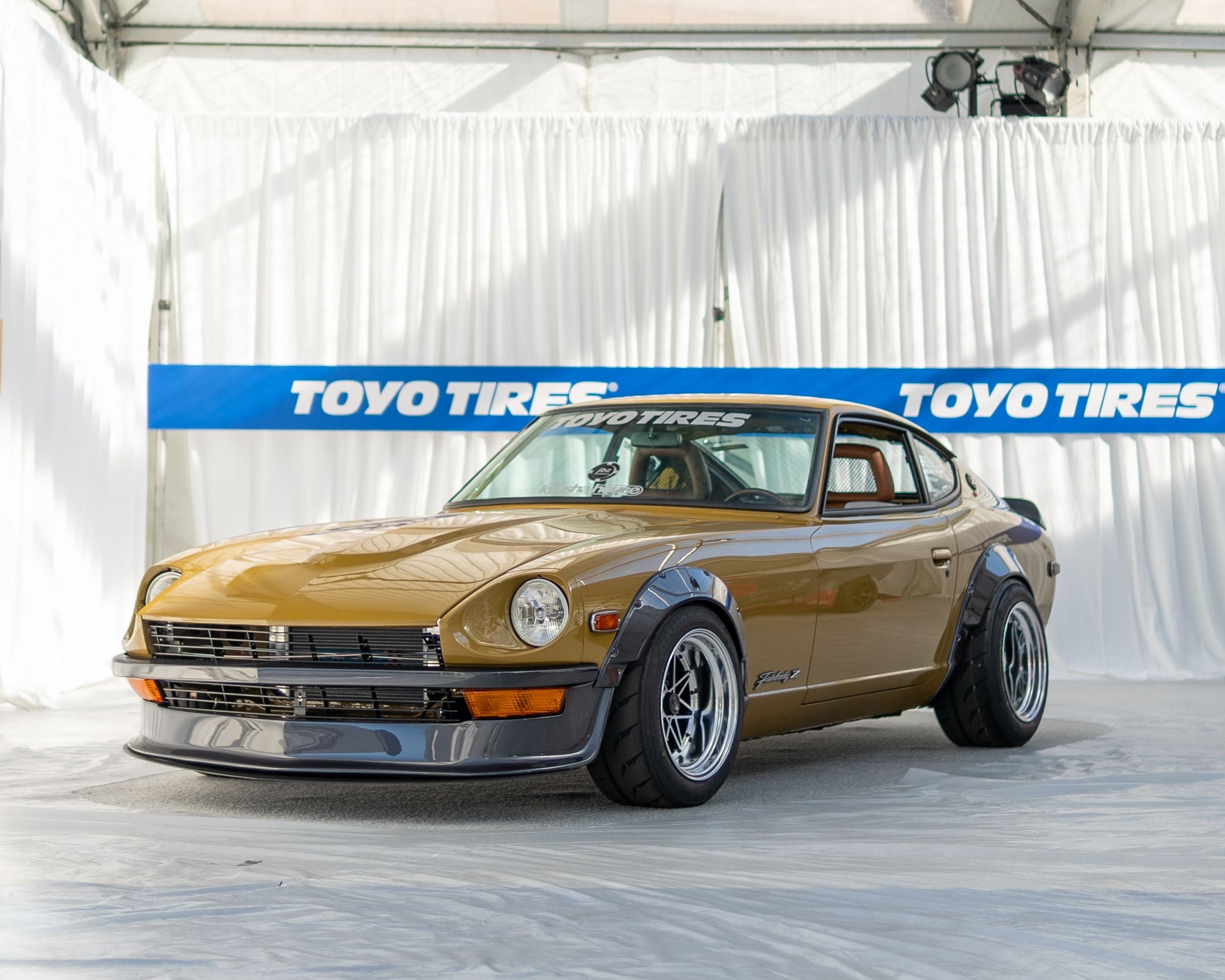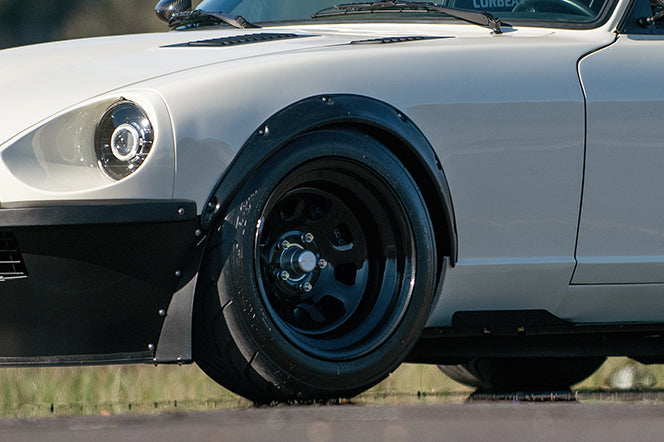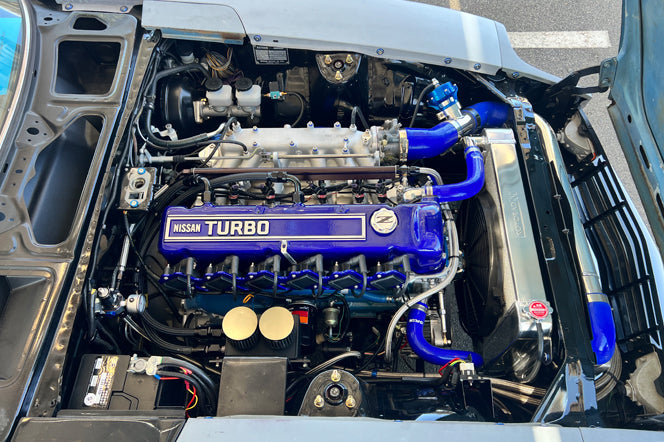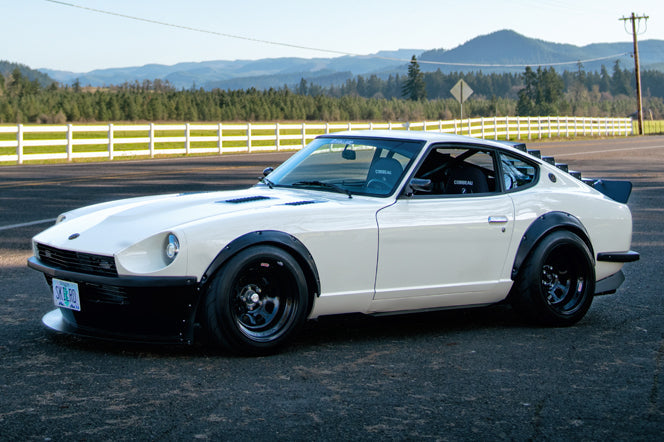When you're looking for new fender panels for your old-school Datsun Z-series, think 240Z, 260Z, 280Z, and 280ZX, you want to keep your ride looking great, driving smoothly, and holding onto its value.
There are a bunch of options to pick from: you have the originals that you might be able to find on eBay that are a little rusty and dented up, and then others by different makers, ranging from reproductions of the OEM fenders to aftermarket racing parts. They each have benefits - some fit like a glove, others are in tip-top shape, and some make your car's styling unique.
Why does this matter? It's simple, a solid choice now, which means your Z-series will keep turning heads and either stay a classic beauty or show off your style with more of a restomod style. If you're restoring your old, dented, or rusty fender with some new ones, you're in the right place.
Let's talk about the pros and cons of these options!
Disclaimer: This article is authored by a member of the Skillard community and reflects their personal views, not necessarily those of Skillard. We welcome your feedback and corrections in the comments to help us continually improve this content.
Table of Contents
How to Choose Between OEM and Aftermarket Fenders
When picking fenders for your classic 240Z, 260Z, 280Z, or 280ZX, you'll want to think about how tough they are, how much they cost, how well they fit, and what they're made of. These four things will help make sure you find the right one for your needs.
Fenders straight from Nissan are known for their strength and perfect fit. They're made just for your car, so you won't have to worry about whether or not they'll fit if you buy the right part. Of course, they might be a bit more expensive, and they might be a little scratched, dented, or rusty, so there will be a bit of a restoration process to get them to match your car.
On the other hand, aftermarket fenders are typically lighter on the wallet. Even though a lot of these are custom-made, they can still be cheaper than trying to source old Datsun parts. Remember, Nissan isn't making parts for these cars anymore, so you'll have to look for old, used ones! But remember, sometimes companies can use cheaper parts to keep costs down, and that can mean you'll be replacing them sooner than you'd like.

You know the drill - with these aftermarket pieces, you might run into some annoying fitment issues. They could make you spend more time and money just to make them fit right. But with OEM fenders, plug-and-play goes easy on you from that surprise.
The material that your fenders are made from is pretty important, too. It affects both how tough they are and how heavy your ride will be. Sometimes, these aftermarket fenders come with new and improved parts that can offer substantial benefits - like making your car lighter, tougher, or more aerodynamic.
And for people who want to keep things classic, OEM is the way to go. They're legitimate, and they won't give you headaches over their fit or lifespan. But if you're watching your budget or hunting for some specific feature, aftermarket fenders can be your friend.
Just do your homework, check out what other people say, and find a brand you can trust to meet your expectations.
Fitment and Compatibility
When you're hunting for fenders, you want to keep it simple. Think of it like finding the perfect hat; it has to fit just right. Even though these cars are kind of like siblings, swapping parts isn't always a walk in the park; you might think a fender from a 260Z would just pop right onto a 280Z or 280ZX, but don't be fooled - it's not always that easy.

Let's talk about the 280ZX. This one's a totally different story. It has its own style, so swapping fenders with its older kin is going to need some modifications to make it work. And if you're looking at these one-size-fits-all aftermarket fenders, remember that "universal" doesn't guarantee a perfect match; sometimes, they're accurate, and other times, they need some custom fabrication to get them to bolt up.
If you're into giving your Datsun Z a new look, maybe for a sleeker style or to fit larger tires for that race-ready stance, there are full-on Fender kits that look great. But be aware that moving to these bigger fenders could sometimes mean you're signing up for more changes, like changing bodywork or messing with the suspension. It's like committing to a puzzle - you have to put all the pieces together to see the whole picture.
Note: Fender flares are a very popular option for these cars. Most fender flares are designed to work with the OEM fenders and not with aftermarket options. It's important to check the compatibility of your fender flares to see if they'll fit with or without modification. As a whole, though, they are generally compatible with both OEM and aftermarket options.
How to Look at Fender Condition and Repair
So, you're faced with a decision: go for the original pieces or pick from the newer options out there.
Let's make these two choices simpler:
If staying true to the car's roots is super important to you, you might first think about original equipment manufacturer (OEM) fenders. They're like a blast from the past, fitting just right because they're made for your car's model. But here's the thing: these parts are old school, coming from the '60s to the '80s, and let's face it, they've commonly seen better days. Rust is kind of their middle name because steel back then wasn't treated to last like it is now. If you find some that are actually in top shape, they'll definitely cost you more.
On the other hand, aftermarket fenders are great for those looking to improve styling, performance, and durability. There are a variety of styles and fits. The best ones will snug right onto your car without any extra hassle. But if you're looking to save a penny, you might need to do a little bit of changing to get the fit just right. The cool part is that most of them come with modern anodization or powder-coated finishes that fight off rust like a champ and hold up much better than the 50-year-old steel on these cars.
If you're not too worried about sticking to steel, aluminum parts are a lightweight option. We have a ton of great aluminum upgrades for these cars in our store, too.

It comes down to what you value most - keeping rust at a distance, which makes sure everything fits like a glove, staying authentic, or looking for something that'll last a long while. With aftermarket fenders being pretty easy to come by and light on the wallet, they're a solid pick when the real-deal OEM ones are tough to track down or a bit rough around the edges.
Availability and Cost
To recap, your two main paths to choose from are hunting down original parts, which are getting hard to find and can be pricey, or going with new parts made today by different companies.
As far as availability goes, finding original fenders is like a treasure hunt, you might check out special car junkyards or online spots where car lovers chat. But keep in mind, the price can be all over the place, just like the people selling them.
On the other hand, today's market is full of choices for aftermarket options, with fenders made from things like steel, fiberglass, and even carbon fiber, which is super light and looks cool. Prices vary; steel versions might set you back about $795, while carbon fiber ones that mix good looks with lightweight construction can range from $980 to $1,850, sometimes more.

But honestly, not all new fenders are created equal. Some match the original's quality, but others might leave you wishing you'd spent more time digging for the original.
For those watching their budget, "less-than-perfect" new fenders might be a smart pick, like ones that are marked as "blems." They have small beauty marks but do their job well and are friendlier to your wallet. Or, they might be returns. At the end of the day, picking the right fenders will help keep your classic Datsun looking sharp and on the move.
Pro Installation vs. DIY
The original fenders fit your car perfectly because they're the ones that came with your car - of course they'll fit! While the fitment is the easy part, they are best suited for those who aren't shy about restoration projects or rust removal, welding, or bodywork.
Why? Well, you aren't likely going to come into contact with a new one.
Unless you get very lucky on a near-mint, non-rusted used part in your exact paint match (that never happens), you'll likely source some old parts, treat the rust, remove any dents or imperfections, sand, prime, paint, and clear coat. Original fenders are a bit easier to bolt up since they don't need any custom fitting, but the bodywork takes a lot of time.

Aftermarket fenders are the complete opposite. They are ready to install out of the box, and many options don't even need to be painted or are already coated for you. These have loads of options to shake things up; you can go strong with wide fender flares or sporty with extra vents. Heads up, though, these might need a bit more work to get them looking perfect. Sometimes, it's best to call in a pro to handle the difficult bits so your car looks amazing and works perfectly.
Think about what you want and what you're comfortable doing yourself. Whether you choose to keep it classic or go strong, make sure your pick matches your car's style and your own skills. After all, these fenders are like your car's smile, and you want that smile to be just right.
Painting Your New Fenders
When you're looking to give your classic car - like a 240Z, 260Z, 280Z, or a 280ZX - a fresh look with new fenders, the choice between original equipment manufacturer (OEM) or aftermarket parts about price, what's in stock, and whether or not you can get the paint just right for fantastic results.
With OEM fenders, you're aiming to keep your car's original beauty. Start by cleaning the surface with a simple wax and grease remover to get rid of any dirt. Then, you'll take a step-by-step technique with sandpaper, starting roughly at 220-grit and finishing smooth at 600-grit. This prep work sets the stage for painting so that the final product looks great and stands the test of time.
If you're going with un-painted and primed aftermarket fenders, kick things off with a base coat of black primer. First up, you'll sand it down using 320-grit paper and a rough pad to really get it ready. It's super important to smooth out any little bumps before you even think about laying down any primer.

No matter which type of fender you're working with, when it comes to painting, you have to be precise. Lay down a coat of primer sealer, let it dry closely, and then gently sand it with 500-grit paper - watch out not to go too far and sand it off! Grab a tack cloth to whisk away any dust so that your paint goes super clean. Apply your color in thin, even layers to avoid drips and get that perfect, even coating.
Let's be honest: getting that pristine finish takes time - usually more than a day to dry and it can be weeks until it's fully cured and ready to take the abuse of things like compound and polish. For these, sticking with OEM fenders, tracking down the exact original color and getting advice from pro painters can make all the difference in nailing that perfect shade. You'll want to use your car's color code to make sure everything matches up nicely.
Top it all off with a clear coat to give your paint job an extra protective layer against the sun and daily wear and tear. It's in using impressive paint and sticking to these steps. Believe it or not, getting a fantastic finish is all about your prep work. You can take all the time in the world doing the actual painting, but if you overspray onto your windshield or if some wild blows some dirt and dust onto your fresh paint, it's going to look awful!
When in doubt, stick with a pro and have them focus on the paint for you. It's worth it for their air-tight paint booth and their meticulous prep work.
Are You Restoring a Z Car?
The right fenders for your Z car can make a huge difference.
Want to keep its classic look and value? Go for fenders that match the original style. Or, if you like, you can spice things up with wider, flared fenders to add a personal touch.
It's important to take good care of your Z car. Schedule check-ups and keep rust at a distance. Whether you pick original parts or aftermarket ones, it affects how you'll take care of your car later. Plan ahead and you'll keep enjoying your smooth Z car for years!
So, are you looking for custom parts for your Datsun? Skillard has what you need, from high-quality aluminum 240Z bumpers to sleek door cards.

Our website, Skillard.com, has everything to turn your car restoration idea into a reality!





